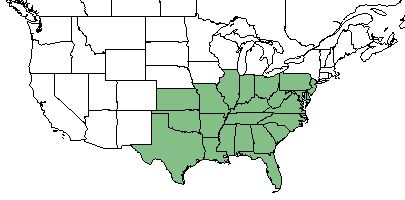Difference between revisions of "Elephantopus carolinianus"
| Line 46: | Line 46: | ||
===Use by animals=== <!--Herbivory, granivory, insect hosting, etc.--> | ===Use by animals=== <!--Herbivory, granivory, insect hosting, etc.--> | ||
| − | This species consists of approximately 2-5% of the diet for large mammals.<ref>Miller, J.H., and K.V. Miller. 1999. Forest plants of the southeast and their wildlife uses. Southern Weed Science Society.</ref> | + | This species consists of approximately 2-5% of the diet for large mammals.<ref>Miller, J.H., and K.V. Miller. 1999. Forest plants of the southeast and their wildlife uses. Southern Weed Science Society.</ref> It has been found to be eaten by white-tailed deer in small amounts.<ref>Gee, K. L., et al. (1994). White-tailed deer: their foods and management in the cross timbers. Ardmore, OK, Samuel Roberts Noble Foundation.</ref> |
<!--==Diseases and parasites==--> | <!--==Diseases and parasites==--> | ||
Revision as of 10:28, 6 May 2019
Common name: Carolina elephantsfoot [1], leafy elephant's-foot [2]
| Elephantopus carolinianus | |
|---|---|

| |
| Photo by the Atlas of Florida Plants Database | |
| Scientific classification | |
| Kingdom: | Plantae |
| Division: | Magnoliophyta - Flowering plants |
| Class: | Magnoliopsida - Dicots |
| Order: | Asterales |
| Family: | Asteraceae |
| Genus: | Elephantopus |
| Species: | E. carolinianus |
| Binomial name | |
| Elephantopus carolinianus Raeusch. | |

| |
| Natural range of Elephantopus carolinianus from USDA NRCS Plants Database. | |
Contents
Taxonomic Notes
Synonyms: none
Varieties: none
Description
E. carolinianus is a perennial forb/herb of the Asteraceae family native to North America. [1] It can reach heights of between 1 to 3 feet with flowers ranging in color from pink to purple.[3]
Distribution
E. carolinianus can be found along the southeastern United States, from Texas to New Jersey.[1] It is also native to the West Indies.[2]
Ecology
Habitat
E. carolinianus proliferates in mesic to dry forests and woodlands. [2] Specimens have been collected from roadside depressions, edge of upland woods, rich woods, moist woods, slope of hardwood forest bluffs, hammock, river floodplain, sandy loam, mixed hardwood, sandy river bank, and mesic floodplain. Soils include moist loamy sand, muddy loam, moist loam, silt, alluvial soil, , and rocky soils.[4] It is listed as a facultative and facultative upland species, where it commonly occurs in non-wetland habitats but can also be found in wetland areas.[1]
Associated species: Eupatorium sp., Pterocaulon sp., Acer rubrum, Fagus grandifolia, Liquidambar styraciflua, Pinus sp., Desmodium sp., Lygodium japonicum, Vernonia sp., Brintonia discoidea, Sanicula canadensis, Hexastylis arifolia, Tipularia discolor, and others.[4]
Phenology
Generally, E. carolinianus flowers from August until November.[2] It has been observed to flower from August to November as well, and fruit from the same time period.[5][4]
Fire ecology
E. carolinianus is not fire resistant, but has a medium fire tolerance. [1]
Use by animals
This species consists of approximately 2-5% of the diet for large mammals.[6] It has been found to be eaten by white-tailed deer in small amounts.[7]
Conservation and Management
E. carolinianus is listed as endangered by the New Jersey Office of Natural Lands Management Department of Environmental Protection and Energy, and by the Pennsylvania Department of Conservation and Natural Resources. [1]
Cultivation and restoration
Photo Gallery
References and notes
- ↑ 1.0 1.1 1.2 1.3 1.4 1.5 USDA Plant Database https://plants.usda.gov/core/profile?symbol=ELCA3
- ↑ 2.0 2.1 2.2 2.3 Weakley, A. S. (2015). Flora of the Southern and Mid-Atlantic States. Chapel Hill, NC, University of North Carolina Herbarium.
- ↑ [[1]] Lady Bird Johnson Wildflower Center. Accessed: May 3, 2019
- ↑ 4.0 4.1 4.2 URL: http://herbarium.bio.fsu.edu. Last accessed: June 2018. Collectors: Loran C. Anderson, Cecil Slaughter, Richard S. Mitchell, R.Kral, R.K. Godfrey, D.B. Ward, R.R. Smith, G. R. Cooley, R.J. eaton, James D. Ray Jr., O. Lakela, J. Allen, R. Lassiter, J. Lassiter, William B. Fox, S.G> Boyle, Bob Lazor, E.S> Ford, J. M. Kane, C.J. Hansen, C.M. Morton, Peter H. Raven, Tamara Engelhorn Raven, Sidney McDaniel, M.B. Brooks, David Morgan, Robert Norris, John Nelson, Delzie Demaree, Virginia Crouch, James Burkhalter, P. L. Redfearn, D.F. Houck, W.D. Reese, Norlan Henderson, John Beaman, G.G. Hedgecock, K. Smith, W.M. Longnecker, B.C. Tharp, J.J. Brady, Fred A. Berkely. States and counties: Florida ( Wakulla, Leon, Volusia, Jackson, Gadsden, Alachua, Gadsden, Liberty, Hernando, Washington, Citrus, Martin, Bay, Dixie, Calhoun, Holmes, Gulf) Georgia (Baker, Grady, Upson, Thomas) Texas (Gonzales, Dallas, Anderson, Cherokee) Tennessee (Blount) North Carolina (McDowell, Chatam) Alabama (Lee, Escambia, Perry, Choctaw) Missouri (Jefferson, Wright, Franklin, Dade) Kentucky (Powell) Mississippi (Jones, Hinds, Yazoo) Louisiana (Lafayette)
- ↑ Nelson, G. PanFlora: Plant data for the eastern United States with emphasis on the Southeastern Coastal Plains, Florida, and the Florida Panhandle. www.gilnelson.com/PanFlora/ Accessed: 21 MAY 2018
- ↑ Miller, J.H., and K.V. Miller. 1999. Forest plants of the southeast and their wildlife uses. Southern Weed Science Society.
- ↑ Gee, K. L., et al. (1994). White-tailed deer: their foods and management in the cross timbers. Ardmore, OK, Samuel Roberts Noble Foundation.